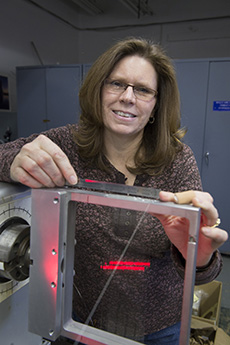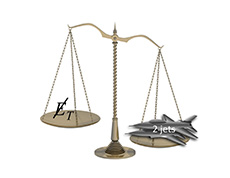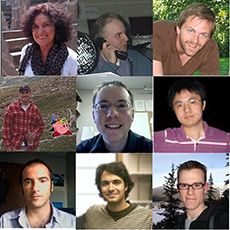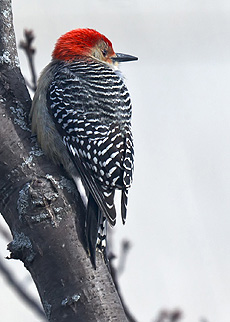|
Have a safe day!
Thursday, Feb. 21
2:30 p.m.
Theoretical Physics Seminar - Curia II
Speaker: Brian Batell, University of Chicago
Title: Higgs Couplings and Precision Electroweak Data
3:30 p.m.
DIRECTOR'S COFFEE BREAK - 2nd Flr X-Over
THERE WILL BE NO ACCELERATOR PHYSICS AND TECHNOLOGY SEMINAR TODAY
Friday, Feb. 22
3:30 p.m.
DIRECTOR'S COFFEE BREAK - 2nd Flr X-Over
4 p.m.
Joint Experimental-Theoretical Physics Seminar - One West
Speaker: Marco Trovato, Scuola Normale Superiore - Pisa
Title: Update of the Dijet Mass Spectrum in W + 2 Jets Events Using the Full CDF Dataset
8 p.m.
Fermilab Lecture Series - Auditorium
Speaker: Angela Belcher, Massachusetts Institute of Technology
Title: Engineering Biology
Tickets: $7
Click here for NALCAL,
a weekly calendar with links to additional information.
Ongoing and upcoming conferences at Fermilab |
|
Thursday, Feb. 20
- Breakfast: sausage gravy omelet
- Green pork chili
- Blazin' buffalo wings
- Mom's meatloaf
- Smart cuisine: finger lickin' oven-fried chicken
- Crispy buffalo chicken wrap
- Assorted pizza
- Greek chicken salad
Wilson Hall Cafe Menu |
|
Friday, Feb. 22
Dinner
Closed
Wednesday, Feb. 27
Lunch
- Broiled tilapia with Thai coconut curry sauce
- Sautéed tri-color peppers
- Jasmine rice
- Tropical coconut cake
Chez Leon Menu
Call x3524 to make your reservation.
|
|
One minute with Wanda Newby, wire chamber winding specialist
 |
Wanda Newby works on wire chambers in Lab 6. Photo: Reidar Hahn
|
How long have you been at Fermilab?
Twenty-eight years. I’ve been the only person doing wire chamber winding at Fermilab for about 18 years.
What’s a typical day for you like?
A typical day at Lab 6 involves the winding, transferring, conductive epoxying or soldering of fine wires to create the planes of different types of detectors in the accelerator beam lines. These detectors give operators information about the beam so as to make adjustments if needed. I also provide wire chamber detector support, for SeaQuest these days, as well as working with an extrusion group at Lab 5.
How did you become interested in this line of work?
I kind of landed into it, really. I started out in this group having soldering skills, and everything else I learned from some very knowledgeable people. Over the years those skills were honed and expanded as I had the chance to work on different types of detectors for here and CERN and wire-type detectors for the Loma Linda Medical accelerator in California as an outside project (with the approval of the lab, of course).
What do you like best about working at the lab?
I like that, in my little corner of the world, I get to play a significant part of something bigger, as in the study of the universe and how it’s made, yet infinitely smaller at the subatomic particle level. I like meeting and working with people from all over the world and have made some great friendships—both at work and on the Fermilab softball field.
What’s next for you?
More of the same, I suspect (and hope). As long as the accelerators are running, they’re going to need instrumentation to measure the beam.
What do you do for fun?
I love music. I enjoy going to gigs and traveling, and I often try to combine the two. I like to read when I have time, tend to my flower garden, ride bikes in the summer and be around friends and family.
—Andre Salles
If there is an employee you'd like to see profiled in an upcoming issue of Fermilab Today, please e-mail today@fnal.gov.
|
2012 Flexible Spending Account reminder
Have you used all of your 2012 Flexible Spending Account funds?
Employees with a 2012 FSA (Healthcare and/or Dependent Care Reimbursement) must spend the remaining balance by the end of the plan year.
- Healthcare expenses must be incurred by March 15, 2013.
- Dependent Care expenses must have been incurred by Dec. 31, 2012.
Claims for both types of accounts must be submitted to the plan administrator, PayFlex, by April 30, 2013. You can:
- submit flexible spending claims to PayFlex online at www.healthhub.com or via fax.
- review a list of eligible expenses and view current balances and claims paid online at www.healthhub.com.
Please note that any flexible spending contributions remaining after the deadline are forfeited.
If you have further questions regarding the FSA debit card, debit card substantiation requests or the PayFlex online tool, you can view an FSA PowerPoint presentation.
Visit the Employee Benefits website for more information about your employee benefits.
|
Obama settles on EPA, Energy Department nominees
From Reuters, Feb. 20, 2013
(Reuters) - President Barack Obama intends to nominate air quality expert Gina McCarthy to lead the U.S. Environmental Protection Agency and nuclear physicist Ernest Moniz to head the Department of Energy as early as this week, according to a source familiar with the process.
McCarthy would likely become the face of Obama's latest push to fight climate change. Currently the assistant administrator for the EPA Office of Air and Radiation, she would replace EPA chief Lisa Jackson, who stepped down this month.
Moniz, a former undersecretary of energy during the Clinton administration, is director of the Massachusetts Institute of Technology's Energy Initiative, a research group that gets funding from industry heavyweights including BP, Chevron, and Saudi Aramco for academic work on projects aimed at reducing greenhouse gases.
Read more |
Attention to nanoscale detail leads to brighter e-beams
From Physics, Feb. 11, 2013
Electron linear accelerators (linacs) used for the most demanding applications—x-ray free-electron lasers (FELs) and linear colliders—must deliver beams with high brightness. In such a beam, many electrons with a narrow spread of energies are bunched into a short pulse, resulting in a high peak current. Along each of the two axes transverse to the beam's direction, the emittance, essentially the product of the size and the angular spread, must be small. The low transverse emittances allow the beam to be brought to a tight focus, while the high peak current enables coherent emission in an FEL or a high collision rate in a collider. Focusing a low-emittance beam might be compared to aiming the spray from a garden hose while sticking your thumb in the end.
Read more |
|
An improved search for the Standard Model Higgs boson
 |
The energy imbalance (represented by ET with a slash through it)
occurs whenever a Z boson decays into two neutrinos
at the same time that a Higgs boson decays into two quarks (represented by the two jets).
|
We can search for the Higgs boson in various ways. To search for it directly, particle physicists look for its decays into pairs of particles such as W+W-, ZZ or two photons. The combined mass of the pair is that of its parent particle, the Higgs boson. The discovery of the Higgs-like particle last summer at CERN was achieved in this way.
But the Higgs boson also decays into a pair of quarks, which look like messy sprays of energy in the detector called jets. Unfortunately, this type of search is much more difficult because this process is overwhelmed by noise from other, less interesting collisions produced by the strong force. Gaining access to Higgs-to-quarks decays, therefore, requires some tricks.
The first trick is to look for the Higgs boson indirectly. That is, we can look directly for the W or Z boson, which sometimes is produced alongside the Higgs particle. This doesn't happen a lot—only about 10 to 20 percent of all Higgs bosons are produced in association with another particle. However, when it does happen, the signatures made in the detector are distinct enough that analysts can leverage the uniqueness of the collision to discriminate against the overwhelming noise.
So what's the unique characteristic we're looking for? That's where the second trick comes in. A team at CDF has performed a search where the Z boson decays invisibly at the same time the Higgs boson decays into two quarks. To spot an invisible decay, one looks for what appears to be a "hole" in the detector. This is an area where you expect to see activity but see nothing. This so-called energy imbalance arises whenever a Z boson decays to a pair of neutrinos, which do not interact with the detector. By searching for such holes and by using an optimized procedure (an improvement of 14 percent over our previous analysis for identifying jets that originated from the Higgs boson decay), the CDF team was able to produce some of the most sensitive limits on the production of the Higgs boson when it decays into the bb final state.
Learn more
—edited by Andy Beretvas
 |
These CDF physicists contributed to this data analysis:
Top row from left: Daniela Bortoletto (Purdue), Tom Junk (Fermilab), Ben Kilminster (University of Zurich).
Second row from left: Mike Kirby (Fermilab), Kyle Knoepfel (Fermilab), Qiuguang Liu (Purdue).
Bottom row from left: Fabrizio Margaroli (Rome Sapienza University and INFN), Karolos Potamianos (LBNL), Homer Wolfe (The Ohio State University).
|
|
Black, white and crimson
 |
A red-bellied woodpecker gazes upon Fermilab's winter landscape. Photo: Marty Murphy, AD |
|
|